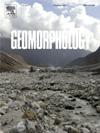拉脱维亚波罗的海东部的古风暴再沉积和冰川期后海岸年代学
IF 3.1
2区 地球科学
Q2 GEOGRAPHY, PHYSICAL
引用次数: 0
摘要
拉脱维亚 494 公里长的海岸由沙质沉积物组成,这些沉积物是过去海岸事件和环境的极佳替代物。我们的研究探索了里加湾西海岸这些未被充分研究的沉积物,并结合了两种砂质石英方法:光激发发光(OSL)测年和晶粒微质谱。我们提供了新的年代学和微沉积结果,以追溯冰川期后的风暴事件,并讨论了波罗的海地区和欧洲其他地区的相关性。OSL 年龄显示的时间跨度很大,介于 10.38 ± 0.61 ka 和 1.04 ± 0.05 ka BP 之间,但它们在剖面上的不一致性,以及地貌和砾石层的陆上位置,证明了风暴作用导致的沉积物迁移。第一个古风暴阶段的年代为 7.6 ± 1.2 ka 至 4.63 ± 0.27 ka,与 Littorina 海的横断和全新世热量最大期相对应,据粗略估计,5 米以上的垂直沉积物重新沉积与该地区最近的风暴相似。微观研究的沉积物记录支持强烈的风暴活动,特别是在 6.07 ± 0.51 ka 之后重新沉积的沉积物中,这可以从裂纹石英颗粒、闪亮颗粒和新鲜表面数量的增加以及数量有限的 V 形痕迹中看出。在 7.6 ± 1.2 ka 到 6.07 ± 0.51 ka 之间,出现了较弱的风暴作用,表现为沉积物中裂纹石英颗粒的数量减少。除了古风暴记录外,滩脊在 5.16 ± 0.33 ka 和 4.47 ± 0.31 ka 之间形成,当时的条件较为干燥,风化沉积发生了两次:4.63 ± 0.27 ka 和 1.55 ± 0.10 ka。本文章由计算机程序翻译,如有差异,请以英文原文为准。
Paleostorm redeposition and post-glacial coastal chronology in the eastern Baltic Sea, Latvia
The 494 km long Latvian coast consists of sandy sediments, which serve as an excellent proxy for past coastal events and environment. Our study explores these understudied sediments along the western coast of the Gulf of Riga and combines two sand quartz-wise methods: optically stimulated luminescence (OSL) dating and grain microtextures. We provide a new chronology and microsedimentary results to trace post-glacial storm events and discuss correlations within the Baltic Sea region and elsewhere in Europe. OSL ages reveal a wide time span between 10.38 ± 0.61 ka and 1.04 ± 0.05 ka BP, but their inconsistency in the profiles along with the onshore position of landforms and gravelly horizons argues for sediment relocation due to storm action. A first paleostorm phase is dated to between 7.6 ± 1.2 ka and 4.63 ± 0.27 ka, corresponding with a transgression of the Littorina Sea and the Holocene Thermal Maximum, and with a roughly estimated vertical sediment redeposition above 5 m similar with the recent storms in the region. Sedimentary record from microstudy supports intense storm activity, especially in sediments redeposited after 6.07 ± 0.51 ka, and it is seen through an increased number of cracked quartz grains, shiny grains and fresh surfaces combined with a limited number of V-shaped marks. Weaker storm action, recorded by a lower share of cracked grains in the sediments, occurred between 7.6 ± 1.2 ka and 6.07 ± 0.51 ka.
A second storm phase occurred at 1.44 ± 0.21 ka, corresponding with the post-Littorina, again with a performance of a weaker storm. Apart from the palaeostorm records, the beach ridges developed between 5.16 ± 0.33 ka and 4.47 ± 0.31 ka along with drier conditions when aeolian deposition took place twice: at 4.63 ± 0.27 ka and 1.55 ± 0.10 ka.
求助全文
通过发布文献求助,成功后即可免费获取论文全文。
去求助
来源期刊

Geomorphology
地学-地球科学综合
CiteScore
8.00
自引率
10.30%
发文量
309
审稿时长
3.4 months
期刊介绍:
Our journal''s scope includes geomorphic themes of: tectonics and regional structure; glacial processes and landforms; fluvial sequences, Quaternary environmental change and dating; fluvial processes and landforms; mass movement, slopes and periglacial processes; hillslopes and soil erosion; weathering, karst and soils; aeolian processes and landforms, coastal dunes and arid environments; coastal and marine processes, estuaries and lakes; modelling, theoretical and quantitative geomorphology; DEM, GIS and remote sensing methods and applications; hazards, applied and planetary geomorphology; and volcanics.
 求助内容:
求助内容: 应助结果提醒方式:
应助结果提醒方式:


